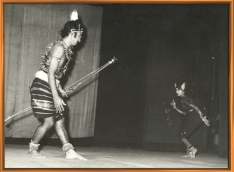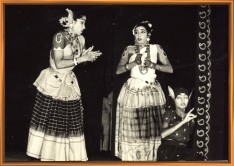

GROUP PRODUCTIONS
SRI VALLI / Kaathal Valli Kanda Murugan (Tamizh) (1975)
"As the monkey is the ancestor of mankind, so is folk dance the ancestor of classical dance"
In 1974, Periasami Thooran asked the Dhananjayans to present a dance drama based on his work Valli Thirumanam, for the Tamizh Isai Sangam program. Instead of a lec/dem, they conceived and presented a dance drama, the first full-scale dance drama production of Bharata Kalanjali with their own students. The title given by Periasami Thooran was Kaadhal Valli Kanda Murugan, which was renamed in later presentations as Sri Valli. With the help of Turaiyur Rajagopala Sarma, an associate of Papanasam Sivan, the music was composed. Sarma, a well-known music composer in films during the forties, had composed for many dance dramas in Kalakshetra, and for the Naatyaanjali and varnam in Attana that the Dhananjayans first performed in their newly structured Bharatanaatyam performance.
Sri Valli is a mythological story in Tamil. This production involves both classical and folk style in both music and dance, making it a judicious mixture for the traditionalists as well as the conservatives.
Sri Valli was a landmark in the history of Bharata Kalanjali in that it was their first full-scale dance drama production.
It was a trendsetter because the Dhananjayans used the work of a contemporary writer, set to music by a contemporary composer, something unusual at a time when the works of only old stalwarts were in vogue.
Kaadal Valli Kanda Murugan was presented for the 26th Tamizh Isai Sangam’s Pann Aaraichi celebrations in Chennai on Dec 22, 1975.
Synopsis:
Sri Valli is the story of Valli, a tribal chieftain’s daughter and her undying love for her Lord Muruga is told with all its colour and humour.
Chitrangi describes the beauty of her friend Valli. Valli and her friends play with a ball. Valli is suddenly struck with divine light and sees the image of Muruga. She narrates the imagined encounter with her lord to her friend. Valli pines for her Lord. Her friends try to distract her and take her to Tinaipunam (maize fields) to drive the parrots away. Narada appears and learns of Valli’s love for Muruga. He reports this to Muruga who promises to go to Tinaipunam in the guise of a hunter to see Valli.
The deer chased by the hunter seeks shelter with Valli. The hunter wishes to take Valli instead. When Valli’s father enters, the hunter turns into a tree. As Valli keeps dreaming of Lord Muruga, he comes in the guise of an old man begging for food. Valli cannot quench the thirst of the old man and takes him to a lake where he pulls her in too. He asks her to marry him and Valli gets annoyed.
Knowing Valli’s fear of elephants, Muruga brings in an elephant and promises to protect the terrified Valli from the elephant if she agrees to marry him. Distraught, Valli agrees and Muruga reveals himself. The celestials celebrate the union of the divine couple Valli and Muruga.
Sri Valli is a mythological story in Tamil. This production involves both classical and folk style in both music and dance, making it a judicious mixture for the traditionalists as well as the conservatives.
Sri Valli was a landmark in the history of Bharata Kalanjali in that it was their first full-scale dance drama production.
It was a trendsetter because the Dhananjayans used the work of a contemporary writer, set to music by a contemporary composer, something unusual at a time when the works of only old stalwarts were in vogue.
Kaadal Valli Kanda Murugan was presented for the 26th Tamizh Isai Sangam’s Pann Aaraichi celebrations in Chennai on Dec 22, 1975.
Synopsis:
Sri Valli is the story of Valli, a tribal chieftain’s daughter and her undying love for her Lord Muruga is told with all its colour and humour.
Chitrangi describes the beauty of her friend Valli. Valli and her friends play with a ball. Valli is suddenly struck with divine light and sees the image of Muruga. She narrates the imagined encounter with her lord to her friend. Valli pines for her Lord. Her friends try to distract her and take her to Tinaipunam (maize fields) to drive the parrots away. Narada appears and learns of Valli’s love for Muruga. He reports this to Muruga who promises to go to Tinaipunam in the guise of a hunter to see Valli.
The deer chased by the hunter seeks shelter with Valli. The hunter wishes to take Valli instead. When Valli’s father enters, the hunter turns into a tree. As Valli keeps dreaming of Lord Muruga, he comes in the guise of an old man begging for food. Valli cannot quench the thirst of the old man and takes him to a lake where he pulls her in too. He asks her to marry him and Valli gets annoyed.
Knowing Valli’s fear of elephants, Muruga brings in an elephant and promises to protect the terrified Valli from the elephant if she agrees to marry him. Distraught, Valli agrees and Muruga reveals himself. The celestials celebrate the union of the divine couple Valli and Muruga.
"In music as well as dance, Sri Valli was path breaking, as established artistes used only old compositions of stalwarts for dance, not music of contemporary composers, a bold step that we ventured to take. This came in for criticism by the orthodox school of thought according to which only a Kshetrayya padam or an ashtapadi comprised pure Bharatanaatyam and anything which did not include these, was a deviation from tradition. Periasami Thooran was considered a contemporary then! Also, Telugu padams were more in vogue than Tamizh padams. In Kalakshetra, hardly any Tamizh padams were done, not even Krishna Nee Beganay, they were so conservative. I used my imagination and presented a lot of Tamizh padams."
Valli Thirumanam got good press reviews even though Subbudu who wrote for Ananda Vikatan, tore the show apart saying ‘Dhananjayan who was born in Kerala has no understanding of the Tamil culture’!
The Dhananjayans have presented Valli Thirumanam over a hundred times in every nook and corner of Tamilnadu. The students were taken everywhere by van and professional charges were paid only to the musicians, and the Dhananjayans managed to keep their company afloat with the modest performance fees they received per show.
SRI VALLI - Reviews - Photo Album
The Dhananjayans have presented Valli Thirumanam over a hundred times in every nook and corner of Tamilnadu. The students were taken everywhere by van and professional charges were paid only to the musicians, and the Dhananjayans managed to keep their company afloat with the modest performance fees they received per show.
SRI VALLI - Reviews - Photo Album
